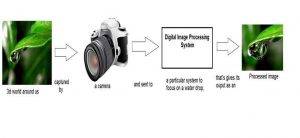Here you can download the free lecture Notes of Digital Image Processing Pdf Notes – DIP Pdf Notes materials with multiple file links to download. The Digital Image Processing Notes Pdf – DIP Notes Pdf book starts with the topics covering Digital Image 7 fundamentals, Image Enhancement in spatial domain, Filtering in frequency domain, Algebraic approach to restoration, Detection of discontinuities, Redundancies and their removal methods, Continuous Wavelet Transform, Structuring Element Decomposition etc.

Digital Image Processing Pdf Notes – DIP Pdf Notes
Digital Image Processing Notes – DIP Notes – DIP Pdf notes : Please find the download links below
Unit I
Digital Image Fundamentals & Image Transforms: Digital Image 7 fundamentals, Sampling and quantization, Relation ship between pixels. Image Transforms: 2-D FFT, Properties, Walsh transform. Hadamard Transform, Discrete Cosine Transform. transform, Slant transform, Hoteling transform
Q&A
Download DIP Notes 1
Unit II
Image Enhancement (Spatial Domain): Introduction, Image Enhancement in spatial domain, enhancement through point operation. types of point operation, histogram manipulation, linear and non – linear gray level transformation, local or neighborhood operation, median filter, spatial domain high-pass filtering.
Q&A
Download DIP 2
Unit III
Image Enhancement (Frequency Domain):Filtering in frequency domain, obtaining frequency» domain filters from spatial filters, Generating filters directly in the frequency domain, Low pass (smoothing) and High pass (sharpening) Filters in Frequency Domain.
Q&A
Download DIP 3
Unit IV
Image Restoration: Degradation model, Algebraic approach to restoration, Inverse filtering, least mean square filters. Constrained Least Squares Restoration, Interactive Restoration.
Q&A
Download DIP 4
Unit V
Image segmentation: Detection of discontinuities, Edge linking and boundary detection, Thresholding, Region oriented segmentation.
Notes
Download DIP Notes 5
Q&A
Download DIP 5a
Unit VI
Image Compression: Redundancies and their removal methods. Fidelity criteria. Image compression models, Source encoder and decoder, Error free compress ion, Lossy compression, JPEG 2000 Standards.
Notes
Download DIP Notes 6
Q&A
Download DIP 6a
Unit VII
Wavelet based Image processing: Introduction to Wavelet Transform, Continuous Wavelet Transform, Discrete Wavelet Transform, Filter banks, Wavelet based image compression, Wavelet based denoising and wavelet thresholding methods.
Notes
Download DIP Notes 7
Q&A
Download DIP 7a
Unit VIII
Morphological Image processing: Dilation and Erosion: Dilation, Structuring Element Decomposition, The Strel function, Erosion. Combining Dilation and Erosion: Opening and closing, the hit or miss Transformation, Overview of Digital Image Watermarking Methods.
Notes
Download DIP Notes 8
Q&A
Download DIP 8a
TEXT BOOKS:
- Digital Image Processing – Rafael C. Gonzalez, Richard E. Woods, 3 edition. Pearson, 2008
- Digital Image Prooessing- S Jayaraman, S Esakkirajan, T Veerakumar- TMH, 2010
REFERENCES:
- Digital Image Processing using MAT LAB —Rafael C. Gonzalez, Richard E Woods and Steven L. Eddings. 2″“ Edition, TMH. 2010.
- Fundamentals of Digital Image Processing -A.K.Iain , PHI, I989
- Digital Image processing and Computer vision— Somka, Hlavac,Boyle- Cengage learning (Indian edition) 2008.
- Introductory Computer vision Imaging Techniques and Solutions- Adrian low, 2008, 2″“ Edition
- Introduction to Image Processing & Analysis – John C. Russ, I . Christian Russ, CRC Press, 2010.
Note :- These notes are according to the r09 Syllabus book of JNTUH.In R13 ,8-units of R09 syllabus are combined into 5-units in r13 syllabus.Click here to check all the JNTU Syllabus books
Frequently Asked Questions
Q1: What do you mean by digital image processing?
A1: Through a digital computer, manipulating digital images is knows as digital image processing. It primarily develops a computer system that performs processing on an image. A digital input is an input of the system. Once the input is attained, system processes the image using different efficient algorithms and gives an image as an output. Adobe Photoshop is the widely known example.
Q2: How does digital image processing works?
A2:

Q3: What are the different phases of image processing?
A3: Phases of image processing include,
- Acquisition of image in a digital form. Scaling and color conversion are main work involved under the acquisition
- Enhancing the acquired image by extraction of some hidden details which could be subjective
- Restoration of image by appealing of an image. It is mainly based on image degradation or mathematical/probabilistic model
- Processing of color image deals with the psuedo color as well as full color image processing color models.
- Processing of wavelets and multi resolution is the foundation of representing images in various degrees
- Compressing an image involves developing some function with image size or resolution
- Morphological processing deals with tools that are useful in representation and description of shape for extracting image.
- Segmentation procedure includes partitioning an image into its constituent objects or parts. In image processing, autonomous segmentation is the most difficult task
- Description and representation is just one of the parts of solution for transforming raw data into processed data. This process follows output of segmentation stage
- Detecting and recognizing the object is a process which assigns a label to an object based on descriptor
